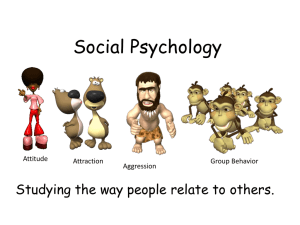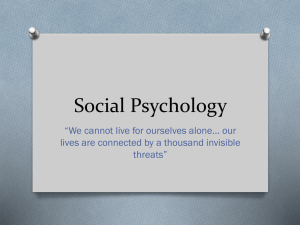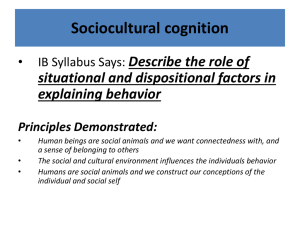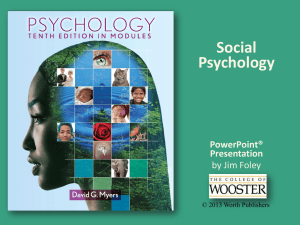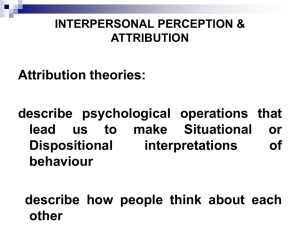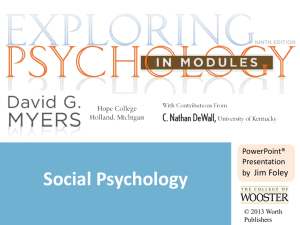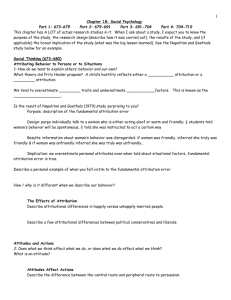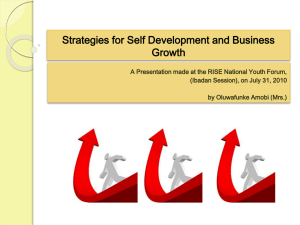Chapter 15 - Social Psychology
advertisement
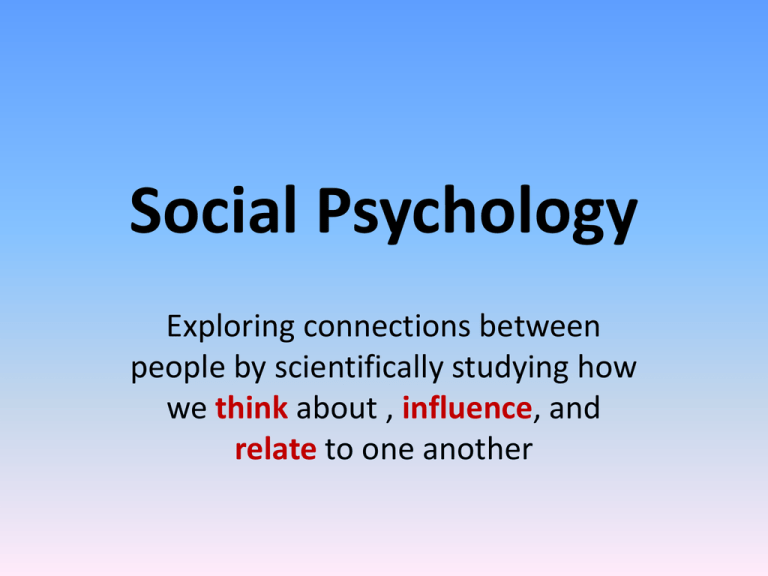
Social Psychology Exploring connections between people by scientifically studying how we think about , influence, and relate to one another Attribution Theory Fritz Heider (1958) The explanation we make of our behavior and the behavior of others fall into two categories: Attribution Theory Situational Dispositional Attribution Attribution Situational Attribution Identifying the cause of an action as something in the situation or environment (external). Example: Joe stole the money because his family is starving. Dispositional Attribution Identifying the cause of an action as something in the person (internal), such as a trait or a motive. Example: Joe stole the money because he is born a thief. The Effects of Attribution Crediting the Situation Happily married couples attribute their spouse’s hurtful remark to a temporary situation: “He must have had a bad day.” Crediting the Person’s Disposition Unhappily married couples attribute the same remark to a mean disposition: “Why did I marry such a hostile person?” Fundamental Attribution Error The tendency for observers, when analyzing another’s behavior, to underestimate the impact of the situation and to overestimate the impact of personal disposition. Fundamental Attribution Error - It is especially prevalent in Western nations, where middle class people tend to believe that individuals are responsible for their own actions. - In Japan, China, and Hong Kong, where people are more group oriented than the West, people are more likely to be aware of situational constraints on behavior. Fundamental Attribution Error - Westerners do not always prefer dispositional attributions. When it comes to explaining their own behavior, they often reveal a self-serving bias: they tend to choose attributions that are favorable to them, taking credit for their good actions (a dispositional attribution), but letting the situation account for their bad or embarrassing actions (a situational attribution). Fundamental Attribution Error Most Westerners, when angry, will say, “I am furious for a good reason.” When they do something admirable, such as donating to charity, they are more likely to attribute their motives to a personal disposition, “I am so generous.” Attitudes Beliefs and feelings that predispose one to respond in a particular way to objects, people, and events. Internal External Attitudes Influences Behavior Our Attitudes Guide Our Behavior If: - outside influence on what we do and say is minimal. - the attitude is specifically relevant to the behavior. - we are keenly aware of our attitudes. Attitudes Follow Behavior The Foot-inthe-Door Phenomenon Roll Playing The Foot-in-the-Door Phenomenon - The tendency for people who have first agreed to a small request to comply later with a larger request. - Act as if you like someone, and you soon will. - Succumb to a temptation and you will find the next temptation harder to resist. Example: The Korean War and captured American soldiers Role Playing Stanley Milgram (1963-1974) “We are all fragile creatures entwined in a cobweb of social constraints.” The constraints are the social norms. Like a cobweb, the constraints are often invisible as they are strong. Examples: - Conversational distance - Role requirements of a “real man” or a “real lady” Role Playing - When you become a college student, marry, or begin a new job – you strive to follow the social prescription. - What we do, we become. - Women who do administrative work develop, over time, more confident and assertive personalities. Cognitive Dissonance Theory - When our behavior and beliefs or attitudes clash, we experience discomfort (dissonance). - To reduce the dissonance and achieve cognitive consistency, we tend to either - Change the belief (rationalize), or - Change the action to fit our belief Conformity Adjusting one’s behavior or thinking to coincide with a group standard Mood Linkage Behavior is contagious. Unconsciously we mimic other’s expressions , postures, and voice tones to feel what they are feeling. Chameleon Effect Conformity Tanya Chartrand & John Bargh (1999) Chameleon Effect - Students worked alongside a confederate who rubbed his or her face or others who shook his or her foot. - Participants tended to rub their own face when with the face-rubbing person and shake their own foot with the foot-shaking person. - Such automatic mimicry is part of empathy. - The most empathetic people mimic and are liked the most. Conformity Solomon Asch (1955) - College students were supposed to answer which of three comparison lines is identical to a standard lines. The answer was obvious. - Many confederates gave the wrong answer. - More than one-third of the time many intelligent and well-meaning students gave the wrong answer to conform with the confederates answers. Conditions for Conformity - One is to feel incompetent or insecure The group has at least three people The group is unanimous One admires the group’s status or attractiveness One has made no prior commitment to any response - Others in the group observe one’s behavior - The particular culture strongly encourages respect for social standards. Reasons for Conformity Normative Social Influence The influence resulting from a person’s desire to gain approval or avoid disapproval. Informational Social Influence Influence resulting from one’s willingness to accept other’s opinions about reality. Discuss Think of a time when you conformed to the norms of a group and the norms were against your beliefs. Give the reasons for this conformity The Obedience Study Stanley Milgram You Tube Video (10:47 minutes) Milgram’s Experiment (Derren Brown) Obedience was highest when: - The person giving the orders was close at hand. - When the person giving orders was perceived to be a legitimate authority figure. - The authority figure was supported by a prestigious institution such as Yale University. - The victim was depersonalized or at a distance. - There were no role models for defiance. The Prison Study Craig Haney & Philip Zimbardo - College students were to stay in prison; some as guards and some as prisoners. - Within a short time - The prisoners became distressed and panicky. They developed emotional symptoms and physical ailment - The guards adjusted to their new power. Some were tough but fair, some were nice, and some were tyranical The Prison Study Craig Haney & Philip Zimbardo You Tube Video (6:48) Philip Zimbardo Stanford Prison Experiment Examples of Blind Obedience 1. Close-at-Hand Authority Carrying out the atrocities of the Holocaust 2. Modeling Defiance Helping the Jews in the French village of Le Chambon Discuss Discuss Milgrams Obedience study in terms of: 1- The effect of the foot-in-the-door Phenomenon 2- How role playing can affect attitudes Group Influence 1. 2. 3. 4. 5. Social Facilitation Social Loafing/Diffusion of Responsibility Deindividuation Group Polarisation Groupthink 1. Social Facilitation Improved Performance of tasks in the presence of others Occurs with simple or well-learned tasks Not with tasks that are difficult or not yet mastered 2. Social Loafing Diffusion of Responsibility The tendency for people in a group to exert less effort when pooling their efforts toward attaining a common goal than when individually accountable. Examples: Bystander Apathy: When others are near, people fail to call the police when they see a woman attacked. Ingham: When pulling a rope alone, students exerted only 82% as much effort as when they new they were pulling alone. 3. Deindividuation The loss of self-awareness and self-restraint occurring in group situations that foster arousal and anonymity Anonymity and Responsibility - The riot after the beating of Rodney King - Women who wore Ku Klux Klan disguises vs. women wearing regular clothes. - The trial held in South Africa in 1980 for murdering an 18 year old woman and burning her body. 4. Group Polarization - The enactment of a group prevailing attitudes through discussion within the group. - If a group is like-minded, discussion strengthens the prevailing opinions. - Talking over racial issues increased prejudice in a high-prejudice group of high school students. - Talking about racial issues decreased prejudice in a low-prejudice group of high school students. Group Polarization, Myers and Bishop (1970) 5. Groupthink The tendency to think alike and suppress dissent. It is fed by overconfidence, conformity, self-justification, and group polarization. Examples: - In 1961, President Kennedy, after meeting with his advisors, approved a CIA plan to invade Cuba and overthrow the government of Fidel Castro: the invasion was a humiliating defeat. - In 1986, when NASA officials made the fatal decision to launch the space shuttle Challenger, which exploded shortly after take off. Apparently, they insulated themselves from the objection of dissenting engineers who tried to warn them that the rocket was unsafe The Power of Individuals Self-Fulfilling Prophesy When one person’s belief about others leads him to act in ways to confirm the belief. - Those who idealize their dating partners as having many virtues and few faults tend to have a more longer-lasting relationships. - According to Sandra Murray, love is not blind, rather it helps create the reality it presumes. Minority Influence - Ghandi – India’s independence - Rosa Parks – Civil Rights Movement - New Inventions Social and Emotional Roots of Prejudice 1. Social Inequalities - When people have money and power and others don’t, the “haves” usually develop unhealthy attitudes. - Discimination can produce either self-blame or anger. - Blame-the victim dynamic – if a friend loses his job, if a woman is raped, or if a prisoner is tortured, it is reassuring to attribute negative dispositional attributions to them. Social and Emotional Roots of Prejudice 2. Us and Them: Ingroup and outgroup Favoring one’s own group versus others 3. Scapegoating Prejudice provides an outlet for anger by providing someone to blame. Cognitive Roots of Prejudice 1. Categorization leads to: - Stereotyping - We overestimate the similarity of people within a groups other than our own. 2. Vivid Cases (Availability Heuristics) - If it happened in the past it is more likely to happen now. 3. The-Just World Phenomenon - Those who succeed must be good, and those who suffer must be bad. The Biology of Aggression 1. Genetic Influences 2. Neural Influences 3. Biochemical influences The Psychology of Aggression 1. Frustration-Aggression Principle 2. Learning: - If aggression pays - Observing aggressive behavior - Culture - The absence of fathers’ care 3. Television Violence 4. Pornography 5. Sexual Aggression Conflict Social Traps – a situation in which the conflicting parties, by rationally pursuing their selfinterests, become caught in mutually destructive behavior. Mirror Image Perception – as we see “them” – as untrustworthy and evil-intentioned – so “they” see us. Attraction - Do birds of feather flock together? Do opposites attract? Does familiarity breathes contempt? Does familiarity intensifies our affection? Does absence make the heart grow fonder? Is out of sight out of mind? Attraction 1. Proximity – Mere Exposure Effect Within certain limits familiarity breeds fondness. Moreland and Scott Beach (1992) - Four equally attractive women silently attended a 200-student class for 0,5,10, or 15 class sessions. - At the end of the course students were shown slides of each woman and asked to rate each one’s attractiveness. - The most attractive one was the one they’d seen more often. Attraction 2. Familiarity - For our ancestors, the mere exposure phenomenon was adaptive. What was familiar was generally safe and what was not familiar was often dangerous. - Evolution has hard-wired into us the tendency to bond with those who are familiar and be wary of those who are unfamiliar. - Gut-level prejudice against those who are culturally different may thus be a primitive, automatic emotional response. Attraction Familiarity Breeds Acceptance When this rare white penguin was born in the Sydney, Australia zoo, his tuxedoed peers ostracized him. Zoo keepers thought they would need to dye him black to gain acceptance. But after three weeks of contact, the other penguins came to accept him. Attraction 3. Physical Attractiveness - We perceive physically attractive people to be healthier, happier, more sensitive, more successful, and more socially skilled, though not more honest or compassionate (Eagly (1991) - Beauty is in the eye of the culture. - Beauty is unrelated to self-esteem and happiness. Attraction Beauty is in the eye of the beholder. When Neanderthals Fall in love. Attraction 4. Similarity - The more alike people are, the more their liking endures (Byrne, 1971). - Love is best sustained “When the lovers love many thing together, and not merely each other.” Journalist Walter Lippmann. Attraction Rewarding Experience Proximity costs less time and effort to develop the friendship and enjoy the benefits. Attractive people are aesthetically pleasing. Those with similar views reward us by validating our own. Familiarity makes us feel safe. We are attracted to people who like us because they enhance our self esteem Attraction Romantic Love Passionate Love An aroused state of intense positive absorption in another, usually present in the beginning of a love relationship. The Two-Factor Theory of Emotion 1- emotions have two ingredients – Physical arousal and cognitive appraisal. 2- Arousal from any source can enhance one emotion or another, depending on how you interpret and label the arousal. Attraction Donald Dutton and Arthur Aron (1974, 1989) Companionate Love The deep affectionate attachment we feel for those with whom our lives are intertwined. - Equity – a condition in which people receive from a relationship I proportion to what they give to it. - Self Disclosure – revealing intimate aspects of oneself to others. Altruism Unselfish regard for the welfare of others Bystander Effect – the tendency for any given bystander to be less likely to give aid if other bystanders are present. Social Exchange Theory (Cost–Benefit Analysis) Our social behavior is an exchange process, the aim of which is to minimize costs. Peace Making Cooperation 1. Contact 2. Superordinate Goals – Muzafer Sherif (1966)shared goals that override differences among people and require their cooperation. Conciliation GRIT – Graduated and Reciprocated Initiatives in Tension-Reduction – a strategy designed to decrease international tensions.
